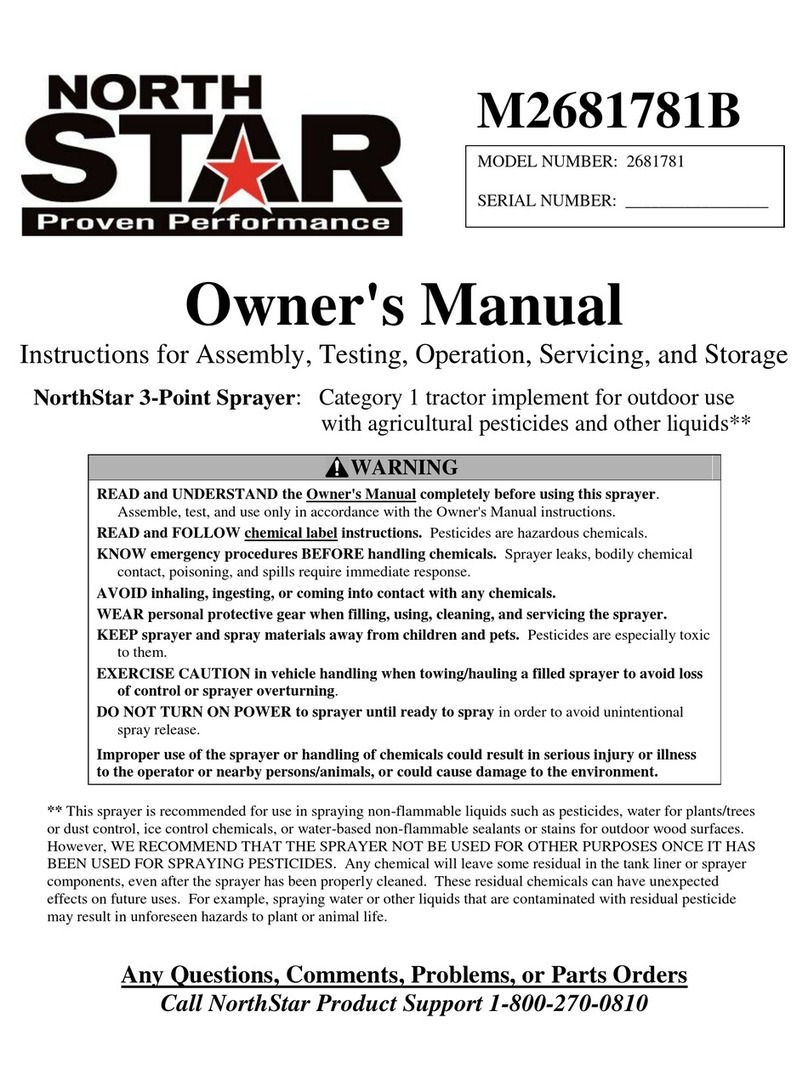
Summary of Important Safety Information (continued)
6
•SEE Troubleshooting section of thismanual before attempting any repairs. Wear personal protective
equipment and follow safety instructions.
After Spraying
•CLEAN sprayer immediately after use according to the directions provided in this manual.
•DECONTAMINATE yourself after you are done spraying and have cleaned the sprayer. Wash all exposed areas
ofthe body with soap and water, and remove and launder clothing.
•DISPOSE OF or STORE remaining chemicals in secure storage with correctly marked container.
TowingSafety
•READ towing safety instructions in your towing vehicle manual.
•DO NOT ALLOW drivers younger than 16 to operate the towing vehicle with the filled sprayer attached.
•MAKE SURE SPRAYER IS SECURELY ATTACHED to vehicle.
•EXERCISE CAUTION in vehicle handling when towingfilled sprayer to avoid loss of control or overturning.
oKeep speed to a minimum so you can maintain control. Reduce speed prior to turns.
oAllow for wider turns and for more distance to stop.
oAvoid any sudden steering maneuvers, starts, or stops that could create sway.
•SLOW DOWNand EXERCISE EXTRA CAUTION on sloped oruneven terrain. Pick the most level route
possible. Drive up and down slopes when necessary, rather than across. Use a vehicle equipped with a roll over
protection system (ROPS)ifyou will be working on non-level terrain.
•BE AWARE of the added length of the sprayer and thatvisibility maybe reduced when making turns or
backing up.
•DO NOT RIDE or TRANSPORT cargo on the sprayer.
•COMPLY WITH all local, state, and federal towing requirements if you will be towing on public roads.
TURN OFF both sprayer and vehicle, and SET BRAKES or BLOCK WHEELS before leaving unattended.
Chemical accident procedures
Immediate response is necessary in the event of sprayer leaks, bodily chemical contact, poisoning, or spills.
Sprayer leak If thesprayer develops a leak, immediately stop spraying. Turn off power to the
sprayer and follow directions below, as applicable.
Bodilychemical
contact Personal contamination can occur when chemicals splash, spill, or spray
directly onto a person.
1. Immediately follow First Aid instructions onchemical label.
General procedures can include:
a) Eyes – immediately flush with water.
b) Skin – wash all contaminated skin surfaces with soap and water.
c) Clothing – remove contaminated clothing. Dispose ofheavily
contaminated clothing per chemical label instructions.
2. Seek medical advice if instructed on the label or the victim experiences
symptoms ofharmful effects. Bring the chemical label for reference.
Poisoningby
ingestion or
inhalation
In case of poisoning from ingestion or inhalation:
If the victim has collapsed or isnot breathing, call 911. Otherwise:
1. Ifyou are the victim, immediately seek assistance from nearby personnel
because you may become incapacitated.
2. Immediately follow first aid instructions on chemical label.
3. Call a poison control center for further advice. In the U.S., call 1-800-222-1222.
Have the chemical label available for reference.
Chemical spills Chemical spills mustbe quickly contained and properly cleaned up.
Refer to the chemical label for any specific clean-up instructions.
General procedures include:
1. Controllingthe spill by stoppingthe source of the spill.
2. Containing thespill so that it does not spread and get into water sources.
3. Cleaning up the spill immediately.
4. Seeking additional advice from:
- Chemical manufacturer. See chemical label for contact information.
- State pesticide regulatory agency. In theU.S., call the National Pesticide Info.
Ctr. at 800-858-7378 for assistance in contacting your state’s agency.








































